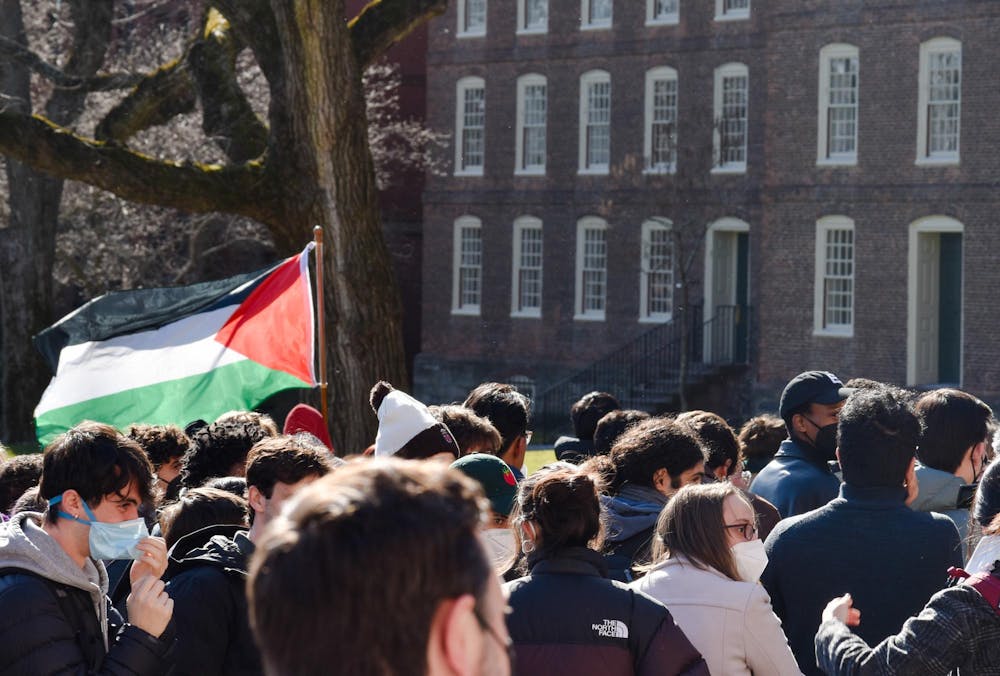Editor’s Note: To help inform The Herald’s ongoing coverage, please fill out this form with your questions about the February hunger strike.
On Thursday, 18 student protesters entered the seventh day of their ongoing hunger strike, coinciding with the start date of the February meetings of the Corporation — the University's highest governing body — where strikers demand the University consider a divestment proposal.
On Feb. 2, President Christina Paxson P’19 P’MD’20 wrote that she would “not commit to bring a resolution” to the Corporation meeting, instead referring students to file a proposal with the Advisory Committee on University Resource Management.
At 9 a.m. Thursday, a group of approximately 200 students joined the 18 continuing strikers in a 32-hour “solidarity strike,” according to Strike Spokesperson Sam Stewart ’24 — a modification from the previously announced 36-hour fast. Stewart added that over 20 University faculty and staff members joined the strike on Thursday.
That morning, approximately 150 students gathered in the Stephen Robert ’62 Campus Center, where students sat out of class in support of the fast. At noon participants rallied on the Main Green, reiterating their call for divestment.
Following the rally, approximately 400 students hosted a picket march around University Hall. In the approximately 15-minute-long event, students held signs and led chants which called for University divestment, claiming that the Corporation is “supporting genocide.”
On Jan. 24, the United Nations International Court of Justice Case, following South Africa’s allegations that Israel is enacting “acts and omissions” that are “genocidal in character … (against) the Palestinian national, racial and ethnic group,” ruled that Israel should “take all measures to prevent genocidal acts.
Students also led chants such as “from the River to the Sea, Palestine will be free” — a phrase which has elicited controversy. Some critics claim the phrase has antisemitic connotations, while others view it as a rallying cry for a free Palestinian state.
Student organizers held hard copies of Brown Divest Coalition’s critical report, which advocates for divestment, outside of University Hall, aiming to distribute the materials to Corporation members as they left the building. The Herald was unable to independently corroborate whether the individuals who were offered reports were members of the Corporation.
The location of Corporation meetings is not open to the public, according to Senior Vice President for Communications Cass Cliatt.
Thursday’s student protestors then hosted a “die-out” outside of University Hall — students lay silently on the grass for 15 minutes, alongside written signs which listed the names of Palestinians who had been killed since Oct. 7.
As of Feb. 8, since Hamas’s Oct. 7 attack on Israel, in which fighters killed 1,200 people and took more than 240 hostages, over 27,000 Palestinians have been killed in Israel’s retaliation, the Associated Press reported.
After the die-out, students began to sing “Joy In Resistance” — a song promoting social change — before returning to the Campus Center to continue their demonstration.
Students involved in the strike have reposted a list of rules that the Student Activities Office has allegedly required of them, including restrictions on noise, sleeping, hosting events of over 50 people without prior approval, display of artwork and handing out masks — a strategy used by organizers throughout the week to prevent striking students from getting sick. On Tuesday, one hunger striker dropped out of the strike after testing positive for COVID-19.
On Wednesday, students involved with the strike shared that SAO informed the groups that it will not permit the sharing of agendas on social media for “unregistered events” hosted in the Campus Center. A social media post shared by BDC says that SAO notified organizers that the advertisements “may lead to student conduct violations for (the) strikers.”
Joie Forte, senior associate dean and director of student activities, wrote in an email to The Herald that many of the publicized events had not been previously registered via SAO. According to Forte, representatives from the office have been working with student organizers throughout the week to register their events.
“SAO has been working closely with student administrative contacts who are managing the activity happening in the Campus Center both at the request of students and, at times, to share information about policy and procedure so students can make fully informed decisions about their activism,” Forte wrote.
Forte wrote that many SAO regulations — including posting events on social media, displaying artwork, microphone usage and live music — except in the Leung Gallery, where live music is not permitted — in the Campus Center are permitted for registered events. She also clarified that sleeping is never allowed in the Campus Center, despite students’ 24-hour access to the building.
Student organizers are allowed to encourage mask-wearing but are not allowed to require it, as the Campus Center is a public space with a mask-optional policy, Forte added.
Students also wrote that SAO did not permit the invitation of guest speakers, which Forte wrote was “not accurate.” She noted that external guests require “guest speaker agreements and safety planning,” highlighting that multiple registered events with professors as speakers have occurred in the past week.
The Corporation is expected to complete its meetings this weekend.
What comes next?
The Corporation began its meetings on Thursday where they will make decisions regarding University policies.
The agendas of these meetings are not disclosed to the public, but any “actions taken by the Corporation” are shared with the Brown community following the end of meeting dates, Cliatt told The Herald.
Editor’s Note: Below is a summary of previous coverage by The Herald detailing common questions about the strike and related University policies.
What are students demanding?
The 18 student protestors are still refusing food until the Corporation — the University’s highest governing body — “hears and considers a divestment proposal” during its meetings that begin Thursday. The strikers say the proposal should be consistent with the 2020 report by the University’s Advisory Committee on Corporate Responsibility in Investment Practices that recommended divestment from “companies which profit from human rights abuses in Palestine.”
Paxson previously refused to bring ACCRIP’s recommendations to the Corporation for consideration, saying that the report “did not meet established standards” for divestment. On Friday, she maintained this position and refused to revisit her decision. She also denied the protestors’ request for a Corporation divestment resolution.
Instead, she encouraged the protestors to submit a divestment proposal to ACURM — the successor to ACCRIP — instead of demanding a Corporation resolution.
The protestors have refused this referral to ACURM, saying that the length of time required to consider this proposal in the committee is “an untenable timeline given the urgency of the crisis in Gaza,” according to a statement from strike organizers to The Herald.
Past demonstrators, including the 41 students who were arrested during a December sit-in on trespassing charges, were previously referred to ACURM when they demanded divestment from “Israeli military occupation.”
What investments does the University hold?
At a November public meeting, representatives from the University’s Investment Office told attendees that Brown’s direct investments do not include weapons manufacturing or those with direct ties to Israel.
In a Sunday email, University Spokesperson Brian Clark echoed this statement writing that Brown is “not directly invested in any defense stocks or large munitions manufacturers.”
A large portion of the University’s endowment is invested in external managers with portfolios that are undisclosed under contractual confidentiality provisions.
The University has only passed two full, official divestment resolutions in the past, The Herald previously reported.
At the November meeting, the Investment Office said none of these portfolios focus on weapons manufacturing and they select “managers whose values are aligned with the Brown community.”
Clark also wrote on Sunday that the University is “confident that our external managers have the highest level of ethics and share the values of the Brown community, including the rejection of violence.”
What health safeguards do the strikers have in place?
The protestors were also cleared to participate in the strike by individual consultation with physicians prior to the demonstration, The Herald previously reported.
“All strikers have been testing for COVID daily and constantly wearing high quality masks, as has anyone who has interacted with them,” Stewart wrote.
According to Stewart, “there are thorough contingency plans in place in case of an emergency” as they continue “monitoring vitals regularly to ensure we are up to date on striker health.”
In a Friday letter to the protestors, Paxson encouraged the students to “safeguard (their) health and well-being” while exercising their “right to protest.” She also highlighted University mental health and well-being resources.
She added that “protest is also unacceptable if it creates a substantial threat to personal safety of any member of the community.”
The University previously disenrolled four students participating in a hunger strike protesting the University’s partial divestment policy of South African apartheid in the 1980s. The then-administration cited health and liability concerns for the disenrollment, according to a 1986 article by The Herald.

Owen Dahlkamp is the managing editor of newsroom on The Herald's 135th Editorial Board, overseeing the paper's news operations. Hailing from San Diego, CA, he is concentrating in Political Science and Cognitive Neuroscience with an interest in data analytics. In his free time, you can find him making spreadsheets at Coffee Exchange.
Samantha was a University News editor overseeing the affinity and activism beat.





